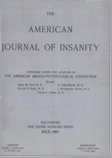SOMATO-PSYCHIC DISORDERS OF OLD AGE
Abstract
1. Increase in the number of patients admitted to mental hospitals with senile psychoses was believed to indicate the need of studying such cases with a view to their prevention and amelioration. One hundred twenty-three cases admitted to the Pennsylvania Hospital from 1930 to 1939 inclusive, and diagnosed at staff conferences after three or four weeks of hospital treatment and observation as senile dementia or arteriosclerotic psychoses, were studied.
2. In this group of long-standing cases treated 25 per cent made social recoveries and were able to return to normal life.
3. Prodromal symptomatology beginning at least six months to one year before hospitalization is usual in such cases. Points aiding in early recognition of the prodromal stage have been stressed.
4. Multiplicity of causation is almost universal, with definite somatic disorders heavily preponderant.
5. General treatment consisting of elimination of foci of infection, correction of toxemias, constipation, avitaminosis, malnutrition, dehydration, fatigue and circulatory deficiencies is essential. Special treatment may be given as indicated.
6. In general accurate prognosis is not possible, but is somewhat more favorable in cases showing correctible somatic disorders.
7. There is reason to believe that the recovery rate of 25 per cent can be duplicated and improved upon, and preventive measures made more effective, as the traditional medical attitude of hopelessness towards the mental disorders of old age gives place to one of scientific inquiry and painstaking clinical effort.
8. Organization of a nation-wide system of preventive treatment for preserving somato-psychic health in the old age group would be, both medically and economically, a richly repaying undertaking.
Access content
To read the fulltext, please use one of the options below to sign in or purchase access.- Personal login
- Institutional Login
- Sign in via OpenAthens
- Register for access
-
Please login/register if you wish to pair your device and check access availability.
Not a subscriber?
PsychiatryOnline subscription options offer access to the DSM-5 library, books, journals, CME, and patient resources. This all-in-one virtual library provides psychiatrists and mental health professionals with key resources for diagnosis, treatment, research, and professional development.
Need more help? PsychiatryOnline Customer Service may be reached by emailing [email protected] or by calling 800-368-5777 (in the U.S.) or 703-907-7322 (outside the U.S.).



